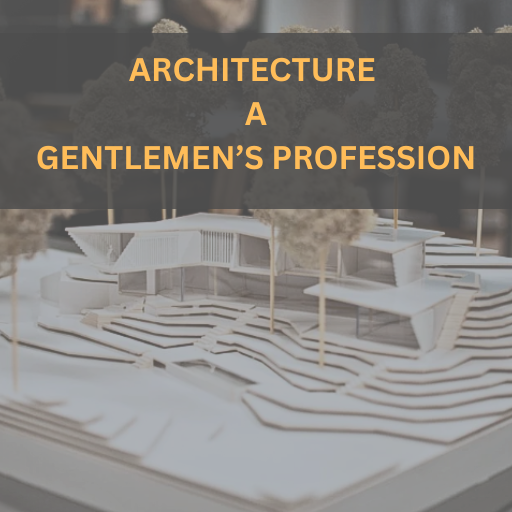
Architecture has always been more than design — it’s a reflection of economics, ownership, and power. In this article from the Architect-as-Developer Series by Mortar Group, we explore how the myth of architecture as a “gentleman’s profession” shaped generations of architects — and why today’s professionals must think like developers, investors, and entrepreneurs. If you’re interested in the business of architecture, real-estate development, or the architect-as-developer model, this essay reframes what it means to control both design and capital.
Author’s Note
In this educational series of The Architect as Developer, I’m aiming to create a full picture of the industry — one article at a time.
My tone will be unapologetic and biased. It’s based on my experience and my thirty-year battle within a professional field that, when I was young, basically ostracized people like me.
If you’re easily offended or prone to whataboutism, real estate and entrepreneurship is probably not for you, and that’s ok as well.
The Myth of the Gentleman
You don’t hear the phrase “architecture is a gentleman’s profession” anymore, but the concept — though softened by time — still stands.
It’s not a proclamation of politics or ideology, nor a rejection of modern progress. It’s simply the way the field evolved. For centuries, architecture belonged to men who didn’t need to be paid. A gentleman lived on inherited wealth or family money, not a salary. Designing buildings was an expression of taste, intellect, and social stature — not a means of earning a living.
The title architect was less a job than a distinction. It implied refinement, education, and detachment from commerce. A gentleman didn’t negotiate contracts or chase fees; those were the tasks of tradesmen. His work was meant to elevate the senses — not to profit.
That said, while the economics of the industry have changed, that worldview baked a myth that still lingers today: real architecture is done for love, not money.
It’s a romantic idea — noble, even seductive — but it has quietly poisoned the profession. It taught generations of architects that financial ambition is beneath them, that earning well somehow dilutes artistic integrity, and that struggle is a badge of authenticity.
In the aftermath — where today’s architects are no longer the wealthy gentlemen of centuries past — the profession roams aimlessly. It left architects completely untrained in economics and business, only to uncut each other and be devoured by the very industry they helped create.
Long hours. Low pay. First fired. Last to get paid – oh, and your the only one that needs professional liability insurance for life. But hey — just tell the architect how “great” their work is, and they’ll take all this abuse… and then some. Every architect is merely an expendable line item on a developers pro forma.
The End of the Mythical Age
To me, the mid-1900s were the myth’s last golden age — a period defined in some ways the wealthy grad-student theorist with a manifesto.
They built one-off conceptual houses on family land, photographed them for magazines, then sold the architectural theory to universities and museums — perpetuating the fallacy.
The easy example is Philip Johnson — Harvard ’43 — who, with a trust fund intact, built The Glass House in 1949 on forty-seven acres in New Canaan, all bought with inheritance.
Then there’s Paul Rudolph, Peter Eisenman, John Johansen, Le Corbusier, Rem Koolhaas, Peter Cook, Richard Meier, Charles Gwathmey, and on and on.
You get the point.
These were the myth’s last aristocrats — architects who didn’t need to make architecture work as a business because it was already working for them as a lifestyle.
The Art of Dependency
I’ll never forget my first day in architecture school in 1994.
Fourth floor, the old Higgins Hall at Pratt Institute in Clinton Hill, Brooklyn — before downtown Brooklyn’s gentrification boom began.
In a hot, run-down studio, my new professor — the kind of man who embodied every stereotype about architects: ego, arrogance, and that faint air of (unearned) superiority — stood before a room of wide-eyed students. Wearing the obligatory dark-rimmed Philip Johnson glasses, he looked at us — kids who, like me, who mostly weren’t from money — and said:
“If you’re here to make money, or to ever live comfortably, you should leave this room now.”
That line never left me. At first, I thought he must be kidding, and maybe I’m slow – because it took me a few more years to realize he wasn’t. Worse, most professionals in the field seemed to drink the same Kool-Aid. Architecture was treated as a sacred pursuit — meant for those above material ambitions.
From the start, we were taught to revere vision and dismiss our own value. Work late. Grind harder. But don’t expect a financial reward for your troubles.
No one taught us how projects are financed, how the business of architecture works, or what a return on cost even means. Talking about money was framed as shameful — as if economics and artistry couldn’t coexist.
Architecture school conditioned generations of students to believe that the true architect is a starving one. And when architects finally begin to break that mold — to seek independence, to think like owners — they’re branded as sellouts.
(For the record — yes, I took that personally, and I still hold a grudge.)
Within the profession, ambition is still treated like a moral failure. Yet in every other field — law, medicine, business — prosperity is seen as a natural extension of mastery.
Only in architecture do we glorify struggle and shame success.
Reframe the Profession
You’re not going to save your peers or change the field.
The architect-as-developer is still a fringe group. I’m not trying to convert the masses. I’m speaking to the few who, like me, felt something about the profession didn’t sit right — the ones with the work ethic and motivation to do more.
Just remember – while most architects reject and mock the idea publicly, quietly, they fantasize about it. Just look online — any content about architects as developers outperforms traditional architectural topics every time.
We’ll do something about it for ourselves and our families. We’ll take control of our financial lives — and do what we enjoy while profiting (gasp!) as well. When you control the economics, you control the outcome.
You create both the idea and the opportunity, and you are only limited by your thoughts. Own the proforma and take control. The architect who understands risk and finance isn’t selling out — he’s buying in and building financial freedom.
In the words of the great Jonathan Segal, “What’s wrong with an architect making some money?”
New to this concept?
Start with ‘The Architect-as-Developer Series: Introduction
Key Takeaways
-
The “Gentleman’s Profession” was never sustainable
-
Architecture’s aristocratic roots made it culturally rich but financially fragile.
-
The profession must evolve from service to ownership.
-
-
Architects must reclaim financial agency
-
Creative freedom only exists when you control the money.
-
Becoming an architect-developer restores both autonomy and impact.
-
-
Development is design — with numbers
-
Learning finance, zoning, and risk management is as crucial as mastering form.
-
The future belongs to those who understand both spreadsheets and sketches.
-
-
The market rewards integration, not separation
-
The most successful firms operate as vertically integrated studios — from concept to completion.
-
Combining architecture, development, and construction aligns creative and financial success.
-

